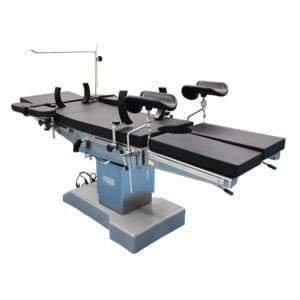Indirizzo
304 Il cardinale nord S.
Dorchester Center, MA 02124
Ore di lavoro
Dal lunedì al venerdì: 7:00 - 19:00
Fine settimana: 10:00 - 17:00
Indirizzo
304 Il cardinale nord S.
Dorchester Center, MA 02124
Ore di lavoro
Dal lunedì al venerdì: 7:00 - 19:00
Fine settimana: 10:00 - 17:00
Nel frenetico regno dell'assistenza sanitaria, l'influenza trasformativa della tecnologia è inconfondibile. Dalla diagnosi al trattamento, i progressi tecnologici non hanno solo migliorato i risultati per i pazienti, ma hanno anche ridefinito gli strumenti e le attrezzature utilizzati dai professionisti medici. Tra questi strumenti, i tavoli operatori si distinguono come un esempio lampante di come la tecnologia abbia rivoluzionato le pratiche mediche. Questo articolo approfondisce i modi intricati in cui la tecnologia ha spinto la progettazione dei tavoli operatori in una nuova era di sofisticatezza ed efficienza.
 Prime sfide e progetti di base
Prime sfide e progetti di baseNei primi giorni della chirurgia, i tavoli operatori erano rudimentali e privi delle caratteristiche ergonomiche essenziali per procedure precise. I chirurghi affrontavano sfide dovute a posizioni fisse, regolazioni limitate e comfort inadeguato per il paziente. Questi tavoli ostacolavano l'esecuzione di interventi chirurgici complessi e procedure prolungate.
Maggiore adattabilità tramite motorizzazione
Con l'infusione della tecnologia, i tavoli operatori hanno subito una notevole trasformazione. Gli attuatori motorizzati hanno introdotto una regolabilità che prima era inimmaginabile. I chirurghi possono ora regolare meticolosamente l'altezza del tavolo, gli angoli di inclinazione, l'inclinazione laterale e le posizioni di Trendelenburg, consentendo un posizionamento ottimale del paziente per diverse procedure. Le micro-regolazioni offerte da queste caratteristiche motorizzate hanno aumentato la precisione e i tassi di successo degli interventi chirurgici.
Materiali radiotrasparenti per immagini senza soluzione di continuità
L'integrazione di materiali radiolucenti, un altro progresso tecnologico, ha rivoluzionato l'imaging durante le procedure chirurgiche. I tavoli operatori ora vantano piani che consentono ai raggi X e ad altre modalità di imaging di penetrare senza ostacoli. Questa innovazione elimina la necessità di riposizionare i pazienti durante l'imaging, semplificando il flusso di lavoro chirurgico e riducendo il disagio del paziente.
I moderni tavoli operatori sono progettati per ospitare una varietà di accessori chirurgici, garantendo un supporto personalizzato al paziente e migliorando al contempo l'efficienza chirurgica. Poggiabraccia, poggiatesta e poggiagambe collegabili possono essere integrati senza sforzo, soddisfacendo i requisiti specifici di ogni procedura. Questa adattabilità riduce al minimo il rischio di complicazioni derivanti dalla compressione dei nervi e facilita gli interventi chirurgici complessi.
La tecnologia ha portato alla luce sistemi di articolazione motorizzati che consentono un posizionamento chirurgico complesso. Questi sistemi consentono ai chirurghi di ruotare e spostare sezioni specifiche del tavolo con una precisione eccezionale. Tali capacità sono inestimabili per procedure ortopediche, interventi chirurgici spinali e altri interventi in cui l'allineamento preciso è fondamentale.
Oltre alle considerazioni sui pazienti, la tecnologia ha dato priorità al comfort e all'efficienza del chirurgo. I design ergonomici, ispirati all'innovazione tecnologica, si adattano alla postura e ai movimenti del chirurgo. Questi design aiutano a ridurre al minimo l'affaticamento del chirurgo durante le procedure lunghe, consentendogli di mantenere concentrazione e precisione per tutto il tempo.
I tavoli operatori ora integrano sistemi di gestione della pressione e caratteristiche di sicurezza come ringhiere e cinghie per prevenire le cadute dei pazienti. L'integrazione guidata dalla tecnologia di questi elementi migliora la sicurezza e il comfort dei pazienti durante l'intervento chirurgico, anche di fronte a procedure prolungate.
Il controllo delle infezioni è una preoccupazione costante nel campo medico. I progressi tecnologici hanno portato allo sviluppo di tavoli operatori costruiti con materiali facili da pulire e disinfettare. Alcuni tavoli sono persino dotati di rivestimenti antimicrobici che inibiscono la crescita di microrganismi dannosi, riducendo il rischio di infezioni post-operatorie.
I tavoli operatori hanno adottato la tecnologia incorporando controlli touchscreen e funzionalità di funzionamento remoto. I chirurghi possono ora effettuare regolazioni in tempo reale senza compromettere il campo sterile. Inoltre, questi tavoli possono connettersi senza problemi ad altre apparecchiature e ai sistemi informativi ospedalieri, facilitando l'assistenza completa al paziente.
 Precisione guidata dall'intelligenza artificiale e oltre
Precisione guidata dall'intelligenza artificiale e oltreMentre la tecnologia continua a progredire, il futuro della progettazione del tavolo operatorio riserva possibilità entusiasmanti. L'intelligenza artificiale (IA) potrebbe essere sfruttata per prevedere il posizionamento ottimale del paziente in base ai dati medici e ai requisiti della procedura. Inoltre, la robotica guidata dall'IA potrebbe consentire regolazioni ancora più precise durante l'intervento chirurgico, migliorando la precisione e i risultati.
D1: In che modo le regolazioni motorizzate hanno migliorato i risultati chirurgici?
A1: Le regolazioni motorizzate consentono ai chirurghi di perfezionare il posizionamento del paziente, ottimizzando l'allineamento anatomico per diverse procedure. Questo livello di precisione contribuisce a migliorare i risultati chirurgici.
D2: I tavoli radiotrasparenti sono compatibili con tutte le modalità di imaging?
R2: Sì, i tavoli radiotrasparenti sono compatibili con varie modalità di imaging, tra cui raggi X e fluoroscopia, poiché consentono a questi raggi di passare senza ostacoli.
D3: La tecnologia può aiutare a prevenire le ulcere da decubito durante un intervento chirurgico?
A3: Assolutamente. I tavoli operatori dotati di sistemi di gestione della pressione ridistribuiscono la pressione, riducendo il rischio di ulcere da pressione durante interventi chirurgici prolungati.
D4: In che modo l'integrazione dell'intelligenza artificiale può migliorare la progettazione del tavolo operatorio?
A4: L'integrazione dell'IA ha il potenziale per prevedere il posizionamento ottimale del paziente, migliorando la precisione chirurgica. Inoltre, la robotica guidata dall'IA potrebbe portare a regolazioni più precise durante l'intervento chirurgico per risultati migliori.
Tavolo operativo il design ha subito una notevole trasformazione attraverso l'infusione della tecnologia. Da una migliore adattabilità e capacità di imaging a un supporto personalizzato e funzionalità adatte al chirurgo, i progressi tecnologici hanno rimodellato il panorama chirurgico. La sicurezza del paziente, il comfort e l'efficienza procedurale sono stati tutti elevati, consolidando il ruolo fondamentale della tecnologia nell'assistenza sanitaria moderna. Mentre guardiamo al futuro, l'orizzonte promette balzi ancora più innovativi, assicurando che i tavoli operatori continuino a essere in prima linea nell'eccellenza chirurgica.